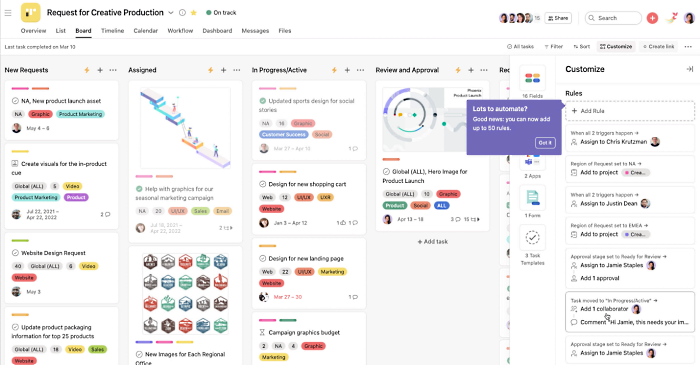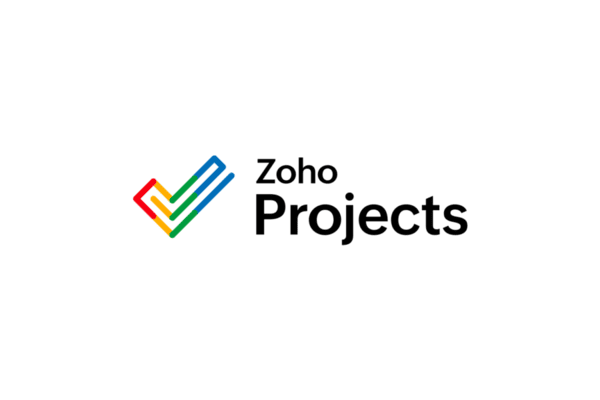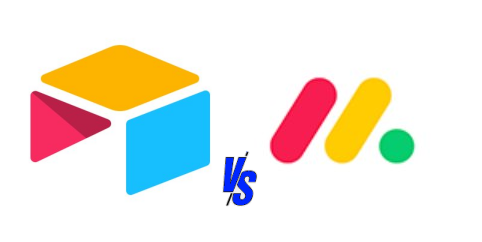Asana is a robust project management system that combines powerful scheduling, collaboration, documentation, and reporting tools in a single secure platform. While it’s a popular option for individuals, SMBs, and enterprises, you may be looking for an option that’s better aligned with your specific needs. Let’s take a look at some of Asana’s pros and cons, as well as some alternatives.
Read more in our complete review of Asana.
Asana’s Use Cases
Organizational Management
Organizations provide their employees with a collaborative work platform that gives every team member the clarity they need to achieve their goals. It easily connects daily work and deliverables to goals and milestones so each team member knows how their tasks and responsibilities ladder up to company objectives.
Management
Teams can easily plan, launch, track, and measure the results of their work. They can create product roadmaps, set goals, align priorities, and track milestones. It also has built-in communication, coordination, and collaboration features to help launch products or features smoothly.
Marketing
Asana includes tools to help teams set marketing strategies, goals, and expectations. Teams can efficiently plan, organize, and execute marketing activities from start to finish. Some of the tools that are essential to marketing teams are multiple work views, request forms, automated workflows, and approval tracking.
Read also: Choosing Marketing Project Management Software
IT Project Management
IT teams use Asana to keep their deployments on track and support teams quickly available to cover any emergency. Teams can use Asana to plan, track, and manage new IT equipment installations. They can also use it to collect and track help desk requests when opening new or expanding existing offices and work sites.
Read more about Asana and other PM software options in our Top 10 Project Management Software Buyers’ Guide.
Pros or Advantages of Asana
Asana offers advanced tools and regular updates of its existing features.
Workflow Automation
Asana lets users automate tedious manual tasks. Rules-based automation help simplify workflows, reduce errors, and save time so teams can spend more time solving problems. Users can set up to 50 Rules per project to automate processes and deliver results faster. Its smart custom rules builder will have users creating automation rules within minutes.

Dynamic Reporting
Asana provides real-time reporting and insights through several tools. It has dashboards, charts, and graphs that enable users to visualize high-level data with zoom-in capability. Interactive reports let users dive into details of the projects and tasks with a simple click on the visuals. It also has templates and intuitive chart builders.
Work Request Management
The Forms feature lets users create a standard work intake process. Users can create multiple forms in a project to support all kinds of work requests. Internal and external customers can request work easily while project teams keep everything centralized, organized, and easy to prioritize and track.
Integrations
Over 100 integrations are available in categories like communication apps and connectors, file storage and reporting services, and security and compliance tools. Asana integrates with Microsoft and Google products such as Teams, Office 365, Power BI, Gmail, Android, and Looker, among others. Its RESTful API also provides users a program interface to much data in its system.
Customization
Custom fields in Asana allow users to track important information to keep work visible to all. It lets teams add any data deemed essential to tasks and projects so stakeholders have a clean but complete line of sight on what is happening. For instance, users can create additional custom fields to hold information about a task’s stage, priority, or cost.
Free Plan
Asana offers a free plan for teams of up to 15 members. The free tier includes unlimited tasks, projects, messages, file storage of up to 100MB each, and an activity log. Also included are several work views like list, board, and calendar views, mobile apps, and integrations. For startups and small businesses, Asana’s free plan delivers enterprise-strength features in a work management solution that’s capable enough to boost productivity and spur business growth
Cons or Disadvantages of Asana
Like any other technology tool, users need to analyze Asana’s pros and cons, then decide if its advantages outweigh the disadvantages.
Learning Curve
New users, especially non-technical users, are often overwhelmed with the number of features and options available when introduced to Asana. While this can usually be solved by training and onboarding, the front-end learning curve can also mean additional time and cost.
Beyond Basics
because teams have access to Asana’s advanced features and capabilities, the platform may be a mismatch for a small team whose projects are simpler or more limited in scope.
Single Assignee for Tasks
Asana assigns a task to only one person to avoid confusion as to who is responsible. However, if the assigned person becomes unavailable, an additional workaround is necessary to keep the work going forward.
No Time Tracking
Asana is a powerful tool for tracking projects, tasks, and assignees. However, it does not have a built-in time tracking feature. Users need to find other time tracking apps and integrate them with Asana to have the ability to track time. This lack becomes an issue when projects involve billing clients, or when team members need to track time against internal budgets.
Limited Exporting Functionality
Asana lets users export data in CSV and JSON formats only. Users cannot export their project data directly into Excel or in PDF. However, third-party reporting and exporting apps like Bridge24 for Asana can simplify exporting requirements.

Ready to Choose Asana Software?
Companies that use Asana are able to communicate more easily, improve team accountability, set goals more clearly, and meet deadlines consistently. Asana provides a simple-to-use but robust work management tool that keeps teams organized and connected.
Evaluating Asana’s pros and cons can serve as a guide to organizations looking for the right work and project management software that best fits their needs.
Asana is a robust project management system that combines powerful scheduling, collaboration, documentation, and reporting tools in a single secure platform. While it’s a popular option for individuals, SMBs, and enterprises, you may be looking for an option that’s better aligned with your specific needs. Let’s take a look at some of Asana’s pros and cons, as well as some alternatives.





